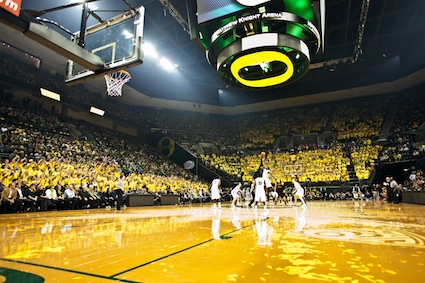Arena Built From Inside Out

The basketball court at the University of Oregon’s new Matthew Knight Arena.
EUGENE, Ore. — Project architects believe the new 418,000-square-foot Matthew Knight Arena at the University of Oregon represents a number of trends in stadium design innovation: multipurpose facility design, the ability to evolve and the use of technology.
The $200 million stadium, which opened in January of this year, serves the men’s and women’s basketball teams and is the home court for volleyball. Additionally, the stadium will host about 30 to 40 concerts and other entertainment events each year.
Designed by Los Angeles-based AECOM, in association with TVA Architects Inc., the new arena replaces the 84-year-old McArthur Court, a project that required the design team to ensure preservation of the iconic “Mac Court” history and memories, according to the firm.
“The seating bowl was the heart of this project,” said Jon Niemuth, principal and design director with Ellerbe Becket [now practicing as AECOM]. “It was very important to capture the intimate, passionate mood of McArthur Court, while feeling modern and not crowded.”
To achieve this, the firm approached the project from a fan’s perspective and designed the new arena from the inside out.
A primary design goal for the new arena was to create a “Theater for Basketball.” The new arena has a capacity of 12,500 and “preserves an intimate, intimidating feel with a seating bowl pitched at 36 degrees in the student section and upper level — the steepest pitch allowed by code,” according to AECOM officials.
Started in 2003, the project is being built to meet LEED Silver certification but may achieve Gold.
Niemuth said that shrinking budgets require schools to do more with less money. Subsidy reductions in the last five years have impacted schools’ ability to fund athletics,
forcing creative solutions to stadium design.
Niemuth said collegiate stadiums vary from professional sports stadiums in terms of their market demographic — specifically, they bring in more income from personal income expenditures than corporate sponsorships, said Niemuth.
“Our biggest trend in the collegiate market is what I call self-sustainability,” he said.
“While revenue is important for all of our domestic clients and domestic leads, the big trend in collegiate athletics is essentially to produce enough revenue or support operations for the athletic department in a way that essentially moves them towards the goal of self-sufficiency, not relying on a subsidy from the larger university.”
Trends in Stadium Design
Ongoing struggles amongst coaches and athletic department staff, caused by scheduled events clashing with needed practice time, resulted in a boom of practice facilities that provide consistently available practice areas separate from the university arenas.
“That’s worked out good, but again, in a profile of different sizes not everyone can afford a standalone practice facility,” Niemuth said. “That could range from $7 million to $8 million, to as high as $20 to $25 million.”
Facility signage for advertising is a means for revenue generation. Due to LED technology and a downward price-versus-value trend, fixed placement signage has increased, Niemuth said. While the cost per square foot for LED can be higher, it provides the opportunity to sell advertisements multiple times, easily refresh content, and create more dramatic brand expressions in a larger area for greater potential revenue.
However, many schools are challenged by the upfront costs, as their budgets aren’t flexible to accommodate “extras” even with the return on investment, he said.
